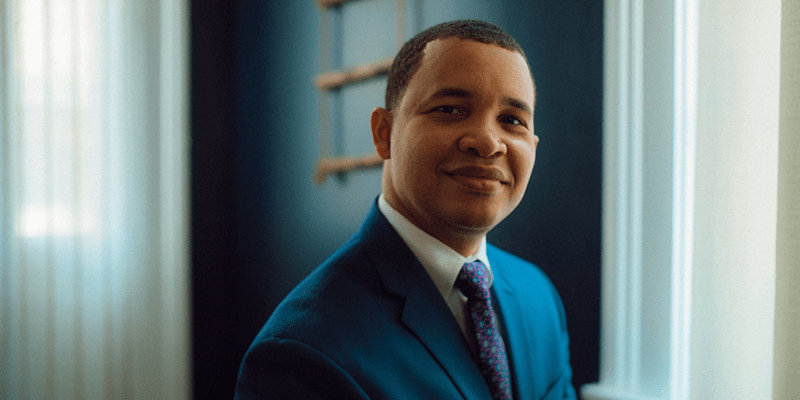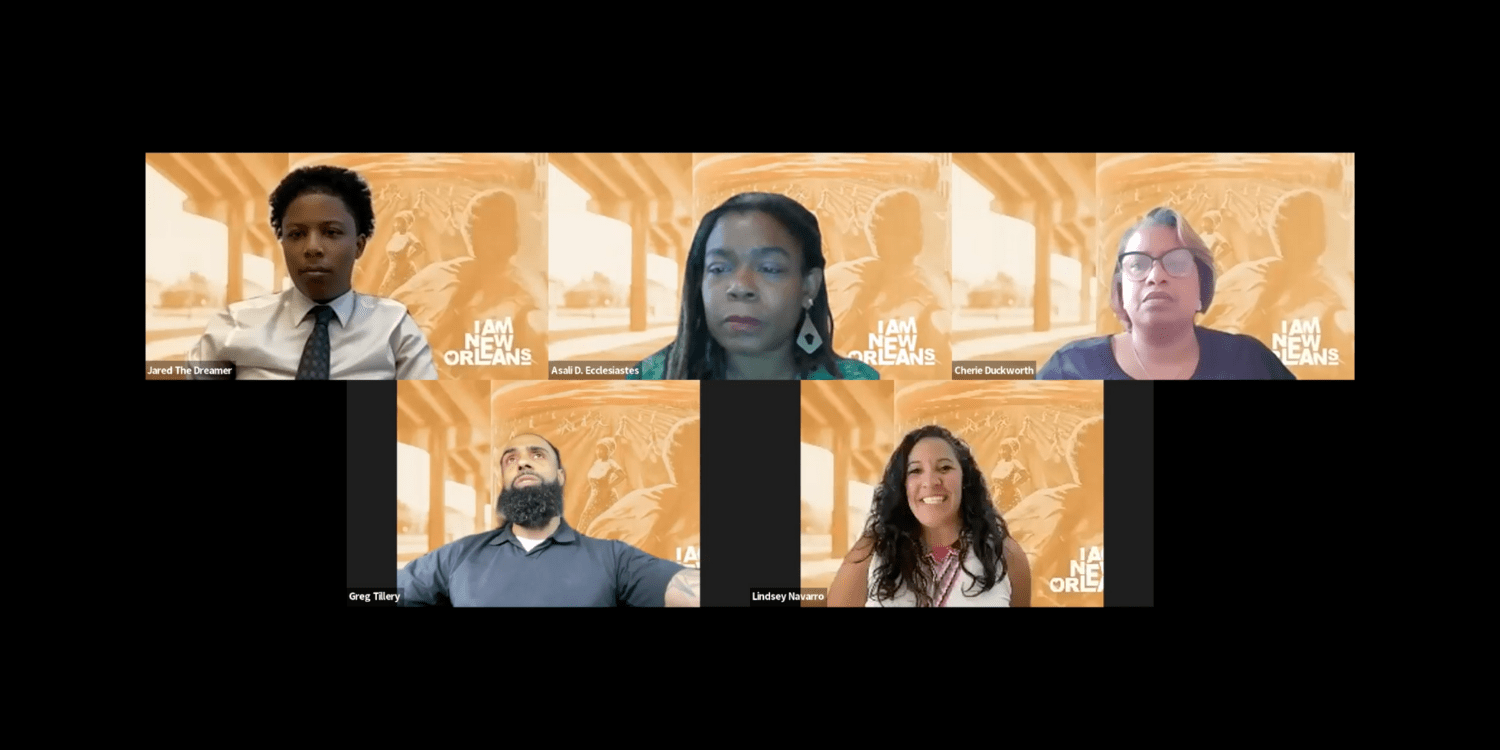Entrepreneurship:
The New American Dream
Entrepreneurship can be a pathway for Black and Brown communities to create wealth, equity and opportunity. And while the number of entrepreneurs of color has increased over the decades in New Orleans, they have been stuck at earning just 2% of sales receipts. Listen to our #IAmNewOrleans community panel as they explore how to create greater access to economic opportunities for entrepreneurs of color, which then benefits our children and families.
And read our interview with Lamar Gardere, executive director of The Data Center. The Data Center uses data and data analysis to support its mission of building a prosperous, inclusive and sustainable community.


Full Panel Discussion
How we can use entrepreneurship as a pathway to making individuals, families and communities economically secure and equitable?
The community panel included Ashé Cultural Arts Center, WeDat’s Chicken and Shrimp, Urban League of Louisiana, El Centro and author Jared R. Green.
Q: Everyone says New Orleans is known for its rich history but is it always an inclusive place for people of color?
A: Through our research, we’ve found that early on in its history, New Orleans was a much more inclusive place than other American cities, welcoming many different races and types of people. There were still enslaved folks, of course, but there was also a significant population of free people of color, which contributed to feeding New Orleans’ early economic growth. However, around the mid-1800s, state law, and therefore, New Orleans began to be more exclusionary, making it more like its Southern contemporaries. It’s no coincidence that this also marks that start of a slow decline in its economic strength. Overall, New Orleans is a little over 300 years old; 150 years of those years were during slavery, and another 100 during the Jim Crow era. Only in the last 50 years has it been possible for African American New Orleanians to fully participate in the economy.
Q: It’s been over 50 years since the Civil Rights movement. Have people of color in New Orleans experienced the same economic growth as their White peers?
A: Unfortunately, no. The inflation adjusted gap between Black and White median household income in New Orleans has grown nearly 63% since 1980. Based on data from 2019, the median income for an African American household is about $29,500 a year. For Hispanic New Orleanians, it’s about $44,000 a year. For White New Orleanians, around $85,000 a year. That’s nearly 190% more than their Black peers. Factor in increased housing costs alongside low household incomes and we learn that many people of color earn below a living wage – the level required to live a reasonable life without government assistance here in New Orleans. In 2021 that threshold was about $71,000 per year for a household consisting of one adult and one child.
Q: How do these economic disparities affect the city of New Orleans, and what has been done to address the problem?
A: Often our community doesn’t realize that economic disparities aren’t just about the people on the wrong side of those disparities. A city, and the systems within it, operate in a connected way. In New Orleans, and in many cities, they work in a way that produces poor outcomes for people of color. Disparities across such large populations make it harder for our entire city to move forward and be competitive. In other words, we need everyone to be in position to perform at their utmost potential to remain competitive with other cities across the nation. If we can’t remain competitive, people won’t want to move and stay here – we won’t grow. We’ve put our data in the hands of a variety of decisionmakers, including government and community leaders at the local and state level, business leaders and folks who are responsible for neighborhood organizations and education. And we’ve seen them take that data and use it to drive new policies within the city, our universities, nonprofit funding and more. But it takes a generation or two or three to move the needle in ways that truly create different outcomes for people.
Q: When talking about entrepreneurship, how have Black and Brown businesses fared compared to their White counterparts here in New Orleans?
A: So, 40% of small businesses in New Orleans are owned by entrepreneurs of color, yet they only receive 2% of the total annual receipts. Many minority-owned businesses lack the connections, investment opportunities, and resources to grow and scale. But these resources are out there. Our economic development organizations can help increase receipts from 2% by ensuring these business owners receive the benefit of available business support resources and thrive within growing industries here in New Orleans.
Q: How has the pandemic and social unrest impacted the economic prosperity of people of color and where are the opportunities coming out of the pandemic?
A: It’s hard to know how today’s events will affect us tomorrow, but, as a rule-of-thumb, disasters exacerbate existing trends. If you were having a hard time pre-pandemic, you’re likely to have a harder time post-pandemic. Fortunately, many of the dire predictions of economic disaster for low-income Americans haven’t panned out, but this is mostly due to the large amounts of unconditional stimulus and protections rolled out in 2020 through the end of 2021. These included several rounds of direct payments to citizens and other programs such as the Advanced Child Tax Credit, the federal moratorium on evictions and ongoing student loan forbearance. The good news is that these measures demonstrated the power of direct and nearly unconditional cash payments to lift many people of color out of poverty. What’s more is that long standing concerns that families would spend this type of unconditional support irresponsibly or that cash payments would discourage people from working simply have not played out. Unfortunately, as these temporary programs shut down, economists are beginning to see signs of the economic stress previously predicted for lower income families as home rental rates remain high and continued supply chain issues keep prices of everyday good artificially high. If any economic lessons can be learned from the pandemic, it’s that families can be trusted to use financial help responsibly and that direct, unconditional payments are quite effective at helping wide swaths of people live above the poverty line.
Q: How have economic disparities impacted New Orleans’ culture bearers?
A: Since Hurricane Katrina, housing costs have increased rapidly, more rapidly than most places across the country. Neighborhoods that were historically Black for almost their entire existence are shifting in other directions in part because they’re becoming unaffordable for your typical New Orleanian. Many of New Orleans’ traditions come from African Caribbean practices and customs and were often practiced in neighborhoods like Tremé. And as generations of families leave these neighborhoods, people are finding it harder to practice their traditions in the places where they’ve come to know them. For anyone who loves our cuisine, culture or heritage, preserving that mix of individuals in close proximity to each other is crucial to continuing the unique flavor that is New Orleans.
Q: Based on the data and research you’ve collected, what are New Orleans’ assets?
A: The River. Water. Our People. From the very start, New Orleans attracted people of all types, which means that our population grew very fast. In fact, at one point, we were the third-largest city in the country. Our diversity helped attract talent from across the country and the Caribbean. Respecting the cultures they brought with them provided the ingredients to build the rich traditions that we know New Orleans for now. Strengthening our cultural economy in an equitable way remains key. And to be a place that everyone acknowledges is different and unique from anywhere else in the country facilitates innovation. It is this innovation and entrepreneurial spirit that will enable us to convert all that we’ve learned over the centuries about managing and living with water into a successful, global water management industry. These and other assets, along with our continued ability to leverage our connection to the Mississippi River, provide rays of sunshine for the New Orleans economy.
Q: What can we do to support the future of New Orleans’ Black and Brown youth? What are the ways we can set them up for professional and economic success?
A: Individual programs that help people who are struggling are always necessary, but if we really want to support the future of New Orleans’ Black and Brown youth, we’ll shift to thinking of how we can change policies, laws and the ways entire systems work in New Orleans and Louisiana. Reducing sky high child poverty is a critical first step. Recent studies show that Louisiana can rapidly see significant reductions in child poverty simply by loosening restrictions on and fully finding existing statewide poverty reduction programs. Alleviating child poverty remains key to unlocking better outcomes across the board, including in terms of education, public safety and economic competitiveness. Gradually increasing our state’s minimum wage to match, then track, Louisiana’s living wage would produce more economic stability for struggling families across the state. While these opportunities are more general in nature, we should also work specifically at improving employment rates for Black males in New Orleans. In the 1980’s, as New Orleans lost oil and gas and port jobs, White, Hispanic and Black men all saw significant declines in employment. Across the 1990’s, all men and women experienced significant gains in employment, except Black men. The failure of our region to ensure Black men shared in this employment surge is at the root of many of the issues we face today. Reworking the many systems that intersect employment to ensure Black male employment reaches that of everyone else’s in the region would pay tremendous economic and quality of life dividends on into the future.
Q: Is there new research in the works that builds off the 2018 Prosperity Index? Can you talk about the findings we can expect?
A: The Prosperity Index helped to make clear the enormity and lasting nature of racial disparities in our region. Upcoming work aims to help us understand how we might change the way our systems work to better address those disparities. The Systemic Inequity Collection is a series of papers we are releasing that looks at several key systems to identify historical antecedents to today’s inequities so that they may be addressed for the benefit of everyone in our region. We’re also continuing work toward better describing, through data, the lives and circumstances of our young people in New Orleans to help decisionmakers better plan for our future. Perhaps most importantly, the Prosperity Index helped The Data Center to see the broad and socially and politically diverse set of people who were willing to work toward a more inclusive New Orleans if they just had the data in hand to help guide their actions. As a result, we are adding the data produced for the Prosperity Index to the set of core data products that The Data Center maintains every year on our website. This means we will soon produce annually updated data, by race, for many of the parishes across our metro area on the topics that matter most. As our region changes and grows, we will continue to produce the data the community needs to support healthy growth for all people.
Q: What economic changes do you hope to see for people of color in New Orleans in the next 10, 15 or even 20 years? What can we do right now to ensure we see these changes?
A: Over the next couple of decades, we would like to see the racial wealth gap in our metro area be significantly and meaningfully reduced. Many factors contribute to wealth, so if we saw disparities decrease there it would be a strong indicator of positive change happening across a number of important systems like employment and wages, homeownership, business ownership, education, workforce, criminal justice, and many others. Currently, Black New Orleanians are nearly 2.5 times more likely than their White peers to be in what’s called liquid asset poverty – a household’s ability to survive at the poverty level with no income for 3 months – and more than twice as likely to be in a household with zero net worth. Improvements in household wealth would enable New Orleanians of color to better financially survive natural disasters like hurricanes, but also common problems like sudden medical issues, job loss, or spikes in housing, food, or energy costs. These events can send previously stable families into economic tailspin, potentially changing the trajectory of otherwise healthy households. Some of my earlier answers talk about what can be done to close the wealth gap, but you can also support efforts like Urban League of Louisiana’s See Change Collective, which aims to eliminate the regional racial wealth gap within our lifetime. Closing the racial wealth gap would be a tremendous signal that our region is prospering, with thriving children and families and the inclusive economic growth we desire.
Related Links
- 2021 Greater New Orleans Startup Report
- Banks & the Black Community: What Can Major Commercial and Retail Banking Institutions Do to Better Support Black Entrepreneurs and Businesses in the U.S.?
- The Business Case for Racial Equity: A Strategy for Growth
- Enterprising Women of Color Program: Powered by WBEC South & Minority Business Development Agency
- Forward Cities and ScaleUp Case Study on New Orleans: How can cities build inclusive local innovation ecosystems?
- The Idea Village
- Mastercard Digital Doors®
- New Orleans Business Alliance: Small Business Growth
- The New Orleans Prosperity Index: Tricentennial Edition
- Urban League of Louisiana: Center for Entrepreneurship & Innovation
- U.S. Department of Commerce’s Minority Business Development Agency: The Louisiana MBDA Business Center
- U.S. Senate Committee on Small Business & Entrepreneurship: Resources
- Venturize: Get on the path to business success

